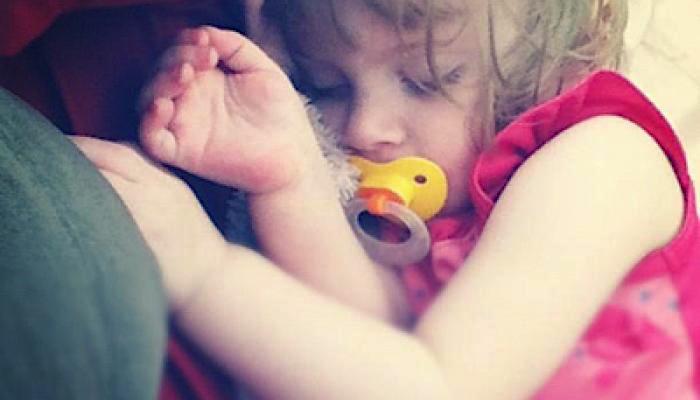Developing Your Blind Child’s Sleep Schedule

I understand first-hand what it means to never get sleep. Our daughter Abigail would only sleep random hours during the day and would be up all night playing and wanting to have “breakfast” and “dinner” when all of us were wanting to sleep.
A lot of people told us to adjust to her, that her needs came first. My husband and I literally had to take SHIFTS. He’d stay up with Abby until 2:30 am and I would take over from 2:30 until he got home from work. We quickly realized that adjusting to our little girl was not helping us and most importantly certainly wasn’t helping HER.
We have two other children aside from our daughter. Abby is 3.5, then we have Bronco who’s 2.5 and Shelby who just turned 1. Around the time Shelby was born we realized we really needed to find out how to get Abigail on a regular schedule. So we did our research.
We took our daughter to see a Sleep Pathologist and what we learned changed our lives for the better. Abigail has what is called Circadian Rhythm Disorder (CRD), a rare disorder in sighted people but common amongst visually impaired or blind persons. CRD occurs when our body’s natural clock for telling time is not functioning. There are a few factors that play into our body’s ability to sleep at the RIGHT times. These factors are as listed below:
- The pineal gland’s ability to produce melatonin.
- The eye’s ability to receive light to initiate the speeding up or slowing down of producing melatonin.
Our body’s internal clock naturally is set to a 24 hour sleep cycle and with cues from light we can fall asleep. When we wake up, light cues our 24 hour clock to reset. People with CRD (also known as Non-24) do not have this luxury; their “master clock” continually delays putting them to bed later and later. This is something we noticed with our little girl.
We could actually track her sleep on the calendar and know what days she’d be asleep for the night and what times. On a Monday she’d go to bed around 8:00 am. The next day 10:00 am and so forth until we’d get one week of a good night’s rest.
When Abigail was a baby it wasn’t like this at all. She was all over the map and we had to suffer through it (so we thought). People told us she’d be 8 or 10 before she started sleeping regualry and even then she’d be up at random hours and fighting to nap during the day.
More research on my part showed that our brains cannot rest our “master body clock” without light perception. This actually affects multiple body functions such as: day and night cycles, body temperature and the release of hormones like melatonin.
Abby’s doctor suggested giving her small doses of Melatonin two hours before bedtime every night. He said that it would eventually help to set her natural body clock to normal. But, our daughter has ONH and her body struggles to regualte those small doses. So every night at 7:15 we started giving her 2.5 ml’s in a dropper. Liquid melation can be purchased at your local pharmacy. Then after a week or so we started giving her 5. As much as the melatonin is making a difference there a few very IMPERATIVE steps you need to take to keep your child sleeping at night.
- Routine! Routine! Routine! I cannot stress it enough. We’ve learned that our natual indiccator of time is light. Yes we have clocks on our walls we can see, but our body is actually responding to the changes of light outside. Normally, our “master body clock” depends 90% of it’s ability to tell time and regualte sleep patterns on light. But because children and people who cannot see the light, they acutally depend 90% on routines and scheudles and 10% on light.
- Don’t let your child sleep at all during the day.
- Stick to it! This is no walk in the park. Getting your child to sleep at night takes time and dedication. You will be exhausted, your child will cry and throw fits, but you have to remember WHY you’re doing this.
- You are your child’s CUE. My daughter depends 90% on her routine and 100% on my husband and I to follow through with that routine.
Below is a chart of “cue phrases and actions” we use to help our daughter:
| Bedtime Cues | Morning Cues | Daily Cues | Meal Time Cues | Bathing Cues | Situational Cues |
| Dinner at 6:30 pm | Wake up at 8:30 am | Lunch at 1:30 pm | 9 am / 1:30 pm/ 6:30 pm | 7:15 pm | Going outside, to families’ houses etc |
| Medicine/Bath at 7:15 pm | Breakfast at 9:00 am | Outside time at 4:00 pm | |||
| (Said quitely) It’s night time Abby, we close our eyes and fall asleep. (We tell her it’s night time as we serve dinner, we tell her it’s night time as we give her her medicine, repeating is key.) | (Said happily and cheerfully) It’s morning Abby! We are all awake with our eyes open. It’s time to be awake and play today! (We express it’s “daytime” all throughout the day and plan activities.) | Abby it’s lunch time! We are all eating now so we can be happy and not hungry! or Abby it’s time to go outside! Let’s put on our socks and shoes and ride in the stroller! We love going outside during the day time! | We let Abby know exactly what time it is, what the meal is and what time of day it is. “It’s breakfast time Abby! 9 o’clock in the morning!” “It’s lunch time Abby! 1:30 in the day!” “It’s dinner time Abby! 6:30 at night!” | We tell Abby throughout dinner that it’s night time. We express to our other children also. “So glad it’s night time, it was a good day!” “Time to get ready for night time and sleep.” We let Abby listen to the bath water run and hold her towel so she knows. | We always explain to her where we’re going, who we’re visiting, their relationship to her, and what time of day or night we are visiting. We talk about it in the car or during the walk on our way. |
Physical cues are her pajamas, what she eats for each of her meals, her towel, blankets and brush etc. Even the way she wears her hair. Our children need us now more than they ever will. Every effort you make towards helping your child/children accomplish daily tasks is preparing them for their future. Is this hard? No. It is TIME consuming. Which makes it seem hard.
Keeping Abby on the routine, though, can be hard. I can’t count the times when I have been completely exhausted, Abigail’s thrown huge fits, bitten me, scratched me, done everything in her power to try and fall asleep during the day time. But I STUCK TO IT. Even though it hurt, more emotionaly than physically, I knew what I was doing was for her benefit and her health.
If you haven’t already, I’d strongly suggest taking your child to see a sleep pathologist. They’ll help your recgonize your child’s personal sleeping pattern (you might want to start by charting your child’s sleep before your appointment so you have something to discuss during that first visit). Once you know their pattern it is easier to repair and start a normal sleeping pattern.
So, here is a recap of what YOU need to do to help your child sleep regularly:
- Develop and STICK to a routine
- Cue your child constantly throughout the day
- No daytime sleeping allowed
- Talk to your child’s doctor about Melatonin
- Make a schedule, write it down, create your own Cue Chart—put them both in the same spot where YOU can see them
 The success of getting your child to sleep regulary is 100% on you. When her sleep pathologist told me this I was so overwhelmed. I am happy to say however, that by following all four of the bullets above that Abby has been sleeping at night and through the night for 4.5 months! It has drastically improved her moods, her appetite and her ability to adapt to new situations. We’ve since moved two times and it hasn’t impacted her new amazing schedule. We had a babysitter for the first time who Abby willingly sat with and played with upon FIRST meeing her. She is starting to eat more, she is learning to walk and is overall a healthier child. I most certainly credit her progress to her sleeping through the night.
The success of getting your child to sleep regulary is 100% on you. When her sleep pathologist told me this I was so overwhelmed. I am happy to say however, that by following all four of the bullets above that Abby has been sleeping at night and through the night for 4.5 months! It has drastically improved her moods, her appetite and her ability to adapt to new situations. We’ve since moved two times and it hasn’t impacted her new amazing schedule. We had a babysitter for the first time who Abby willingly sat with and played with upon FIRST meeing her. She is starting to eat more, she is learning to walk and is overall a healthier child. I most certainly credit her progress to her sleeping through the night.
I know you can do it. I did it with 3 kids under 3 and in diapers. If you need encouragement or advice please contact me as often you’d like! You can email me or give me a call at 801-403-1502. I am here to help!
For more information on Non-24 Disorder, Master Body Clock and Bedtime Cycles please visit: Non-24.com.

Related Posts

Eye Conditions and Syndromes, Visual Impairment
Neuralink Announces Plans to Restore Sight to the Blind with Brain Chip
Elon Musk’s company Neuralink has announced plans to begin human trials of its new “Blindsight” brain chip by the end of 2025.

Visual Impairment
The Gift of Understanding: How a Young Child Helps His Blind Father Navigate Life
When a parent is blind, it’s natural for people to wonder how their sighted child will adapt. Will they struggle to understand their parent’s needs? Will they feel burdened by...

Braille and Literacy, Toys, Visual Impairment
24 Braille Toys for Kids Who are Blind
Everything from alphabet blocks to raised line coloring pages and activity books to puzzles to card and board games... and so much more! And it's all in braille ready for...